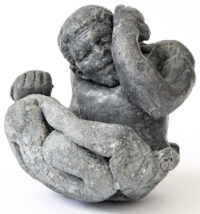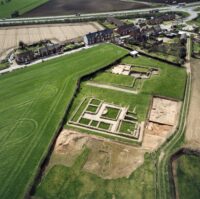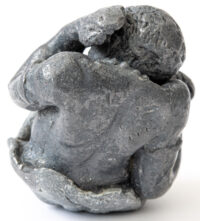 New research into a 1st century A.D. Roman lead figurine found in Wall, Staffordshire, almost 100 years ago has found that it does not represent an enslaved African as archaeologists originally thought, but rather a warrior. The tell-tale clue had been overlooked: a small socket in his right hand that would originally have held a weapon, probably a bronze spear.
New research into a 1st century A.D. Roman lead figurine found in Wall, Staffordshire, almost 100 years ago has found that it does not represent an enslaved African as archaeologists originally thought, but rather a warrior. The tell-tale clue had been overlooked: a small socket in his right hand that would originally have held a weapon, probably a bronze spear.
Now part of the parish of Wall in Staffordshire, the Roman site of Letocetum was founded as a temporary military marching camp in the late 40s A.D., the early ears of the Roman conquest of Britain. The first timber fort was built around 55 A.D. during the campaign of governor Aulus Didius Gallus against the rebel Brigantes king Venutius.
(Juicy sidenote: His rebellion was really against his ex-wife Cartimandua, Queen of the Brigantes and ally of Rome, who had scandalously divorced him to marry his lowly armour-bearer Vellocatus. She wasn’t Venutius’ consort; she had inherited the crown in her own right, so when she dumped him she remained queen. He went to war to wrest leadership of the Brigantes out her hands and that meant fighting Rome too when they came to her defense. He had no particular beef with them.)
 A hilltop fort was built around 58 A.D. to garrison Legio XIV Gemina. They moved on within a couple of years, but the fort only grew in importance because it occupied a central position at the junction of the Roman military road network, linking Watling Street (which ran northwest from the Kentish coast to Wroxeter, Shropshire) and Ryknield Street (which ran south to north from Gloucester to York). It was reconstructed several times. In the late 1st century, a large public bathhouse and a mansio, a sort of private inn that lodged imperial officials traveling the roads, were built. The Roman remains visible above-ground at the site today are parts of the baths and mansio.
A hilltop fort was built around 58 A.D. to garrison Legio XIV Gemina. They moved on within a couple of years, but the fort only grew in importance because it occupied a central position at the junction of the Roman military road network, linking Watling Street (which ran northwest from the Kentish coast to Wroxeter, Shropshire) and Ryknield Street (which ran south to north from Gloucester to York). It was reconstructed several times. In the late 1st century, a large public bathhouse and a mansio, a sort of private inn that lodged imperial officials traveling the roads, were built. The Roman remains visible above-ground at the site today are parts of the baths and mansio.
The figurine is believed to have been discovered in the 1920s at a 1st and 2nd century burial ground on Watling Street, which is today on the west side of Wall but was outside the town walls of Letocetum. The find was not made in a formal excavation and was not recorded at the time, but archaeologists believe it was a grave good interred with cinerary remains. The bottom half of it is partially melted, something that could have happened when the ashes from the funeral pyre were scattered in the grave over the goods.
 Just over two inches high, the figurine wears armlets on his upper arms and a necklace of beads. It was the seemingly pained expression on his face that spurred the original interpretation of the figure as slave bent over in suffering. While distorted from the heat, the legs appear to be crossed as if he were sitting on the ground. In the 1990s, with many more examples of Roman artworks depicting African figures known, the figurine was reassessed and his cross-legged posture reinterpreted as a seated wrestler as seen in many comparable examples discovered in Continental Europe.
Just over two inches high, the figurine wears armlets on his upper arms and a necklace of beads. It was the seemingly pained expression on his face that spurred the original interpretation of the figure as slave bent over in suffering. While distorted from the heat, the legs appear to be crossed as if he were sitting on the ground. In the 1990s, with many more examples of Roman artworks depicting African figures known, the figurine was reassessed and his cross-legged posture reinterpreted as a seated wrestler as seen in many comparable examples discovered in Continental Europe.
The spear socket was spotted only this year when the figurine was photographed in great detail.
With the addition of a spear we can now see that the figurine stood upright, holding out his weapon, rather than sitting with legs folded as previously suggested. The image of an African man shown with his spear appeared in art in the Classical period as well as more recently, and is often called the African Warrior. The figurine from Wall is now reinterpreted as a representation of that persona.
As to how the figurine came to be at Letocetum, it is very unlikely that this piece was made in Britain, though once they had been introduced, metal figurines were made here. The Wall figurine is sufficiently unusual to indicate that it was made on the Continent, but it may have come from somewhere much closer to the Mediterranean than Gaul.
During the Roman invasion of Britain huge numbers of people travelled here, originating from many different parts of the Empire. While we do not have a clear provenance for the figurine, the evidence that it was used as a grave good at Wall suggests one possible history – that an individual acquired this unusual piece of art on the Continent, travelled thousands of miles with it, and was buried with it in a foreign land.
Friends,
Livius mentions that the figure was found in a cemetery outside the walls of Letocetum. Not stated is that nearly all Roman burial grounds were outside of town precincts. I’m no Rome geek, so I don’t know if this was for ritual reasons, superstitious fear of the dead, civic hygiene or urban planning. Maybe all of the above.
An exeption was Hadrian who had a tomb and funerary temple built within Rome’s walls for himself and his family, later holding the ashes of subsequent emperors and other big shots.
The Mausoleum of Hadrian is better known today as the Castel Sant’Angelo. As a castle, it served as a last redoubt for Popes (notably Clement VII). The Castel is connected to the Vatican by the fortified Passetto di Borgo, which proved handy for Clement in 1527 when the last of his Swiss Guards dragged him through it to safety.
Yours Aye,
Lord Mungo Napier,
Laird of Mallard Lodge (SCA) 🦆